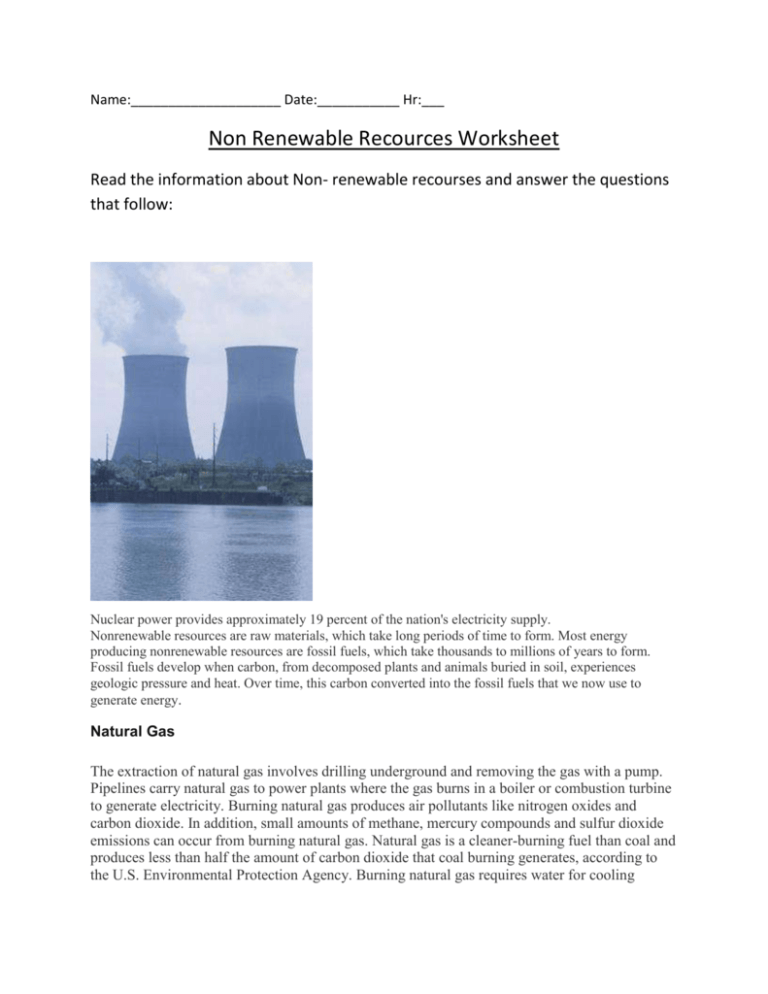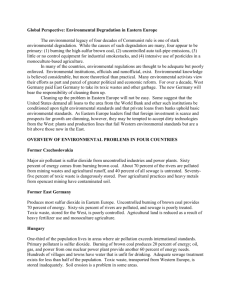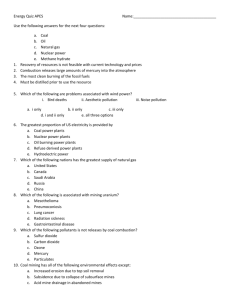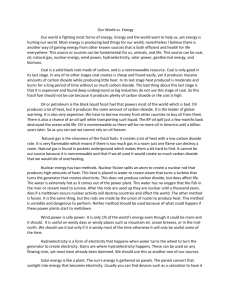Non-Renewable Resources WS
advertisement

Name:____________________ Date:___________ Hr:___ Non Renewable Recources Worksheet Read the information about Non- renewable recourses and answer the questions that follow: Nuclear power provides approximately 19 percent of the nation's electricity supply. Nonrenewable resources are raw materials, which take long periods of time to form. Most energy producing nonrenewable resources are fossil fuels, which take thousands to millions of years to form. Fossil fuels develop when carbon, from decomposed plants and animals buried in soil, experiences geologic pressure and heat. Over time, this carbon converted into the fossil fuels that we now use to generate energy. Natural Gas The extraction of natural gas involves drilling underground and removing the gas with a pump. Pipelines carry natural gas to power plants where the gas burns in a boiler or combustion turbine to generate electricity. Burning natural gas produces air pollutants like nitrogen oxides and carbon dioxide. In addition, small amounts of methane, mercury compounds and sulfur dioxide emissions can occur from burning natural gas. Natural gas is a cleaner-burning fuel than coal and produces less than half the amount of carbon dioxide that coal burning generates, according to the U.S. Environmental Protection Agency. Burning natural gas requires water for cooling purposes. Using water from local rivers and lakes kills aquatic life and affects the local ecosystem. (See References 2) Oil Drilling operations remove oil from underground reservoirs. Transported oil enters refineries, which purify the oil by removing sulfur, metals and nitrogen. Further refining separates the oil into propane, diesel fuel, jet fuel, kerosene and gasoline. Further transportation brings these products to power plants, which generate electricity by burning the fuel in turbines. Generating energy from oil produces potent greenhouse gases, such as carbon dioxide, nitrogen oxides, sulfur dioxide and methane. In addition, drilling engines, wells, collection equipment and transportation units produce greenhouse gas emissions. Solid waste and wastewater sludge are byproducts of oil refining that contain toxins and metals. Contaminated and heated water, released from refineries, pollutes local streams and aquatic habitats. In addition, oil drilling can contaminate groundwater and oil spills can radically damage ecosystems. (See References 3) Coal Coal extraction involves underground and surface mining. Both mining processes can result in soil and water pollution. Soil contamination that occurs at mining sites lasts for many years. Mountain top removal, a form of surface mining for coal, involves the use of large machines and explosives to expose coal seams below the surface. Every step of the coal mining, cleaning and transporting process generates air pollutants. The average emission rate of carbon dioxide generated from burning coal for energy is 2,249 lbs. per megawatt hour, according to the EPA. Burning coal also releases the potent greenhouse gas methane. Water contamination occurs at mining sites and power plants, and pollutes nearby bodies of water. (See References 4) Uranium Nuclear power plants use uranium to generate electricity. Although uranium-containing rocks exist across the world, there is no natural process that regenerates uranium at a sustainable rate. For this reason, uranium is a nonrenewable resource. The nuclear fission process, which generates energy from uranium, does not produce harmful greenhouse emissions. However, uranium mining and refining relies on energy from fossil fuels. In addition, the building materials and energy required to manufacture and run nuclear power plants generate air pollutants. Each year, the U.S.'s nuclear energy plants produce 2,000 metric tons of radioactive wastes. These wastes remain radioactive for thousands of years and require secure storage sites. (See References 5) Name:_____________________ Date:_____________ Hr:______ Non Renewable Recources Worksheet 1. What provides approx. 29% of the Nation’s electricity supply?______________________ 2. Nonrenewable resources are ___________ materials. 3. How does natural gas generate electricity?_______________________________________________________________ ________________________________________________________________________ 4. Burning natural gas causes air pollutants such as?_____________________________________________________________________ 5. Natural gas is a _________- burning fuel than coal 6. How do refineries purify oil?_____________________________________________________________________ ________________________________________________________________________ 7. drilling engines, wells, collection equipment and transportation units produce:________________________________________________________________ 8. What else can drilling oil contaminate?________________________________________ 9. What is the average emission rate of carbon dioxide generated from burning coal for energy?_________________________________________________________________ 10. What greenhouse gas does burning coal release?________________________________ 11. Where does water contamination occur?__________________________________________________________________ 12. There is ____ natural process that regenerates uranium at a sustainable rate.









